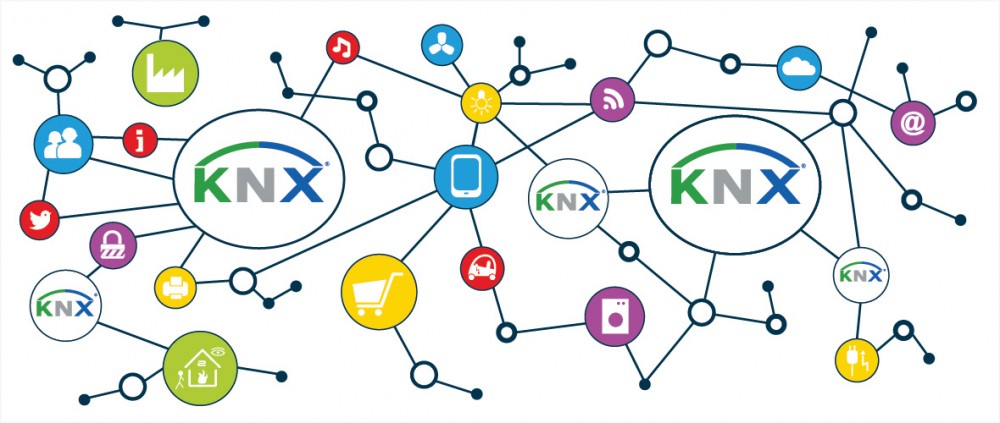
KNX is an open standard (see EN 50090, ISO/IEC 14543) for commercial and domestic building automation. KNX devices can manage lighting, blinds and shutters, HVAC, security systems, energy management, audio video, white goods, displays, remote control, etc. KNX evolved from three earlier standards; the European Home Systems Protocol (EHS), BatiBUS, and the European Installation Bus (EIB or Instabus). It can use twisted pair (in a tree, line, or star topology), powerline, RF, or IP links. On this network, the devices form distributed applications and tight interaction is possible. This is implemented via interworking models with standardized data point types and objects, modeling logical device channels.

The KNX standard has been built on the OSI-based EIB communication stack extended with the physical layers, configuration modes, and application experience of BatiBUS and EHS.
KNX installations can use several physical communication media:
Twisted pair wiring (inherited from the EIB standard. (The before inherited BatiBUS communication medium (TP0) is no longer part of the KNX Specifications.)
Power-line networking (inherited from EIB standard. (The before inherited EHS communication medium (PL132) is no longer part of the KNX Specifications.)
Radio (KNX-RF)
IP (also referred to as EIBnet/IP or KNXnet/IP)
KNX is not based on a specific hardware platform and a network can be controlled by anything from an 8-bit microcontroller to a PC, according to the demands of a particular building. The most common form of installation is over twisted pair medium.
KNX is an approved standard by the following organizations.
International standard (ISO/IEC 14543-3)
European standard (CENELEC EN 50090 and CEN EN 13321-1)
US standard (ANSI/ASHRAE 135)
China Guobiao (GB/T 20965)
It is administered by the KNX Association cvba, a non-profit organization governed by Belgian law which was formed in 1999. The KNX Association had 443 registered hardware and software vendor members from 44 nations as at 1 July 2018. It had partnership agreements with over 77,000 installer companies in 163 countries and more than 440 registered training centers. This is a royalty-free open standard and thus access to the KNX specifications is unrestricted.

KNX architecture
KNX devices are commonly connected by a twisted pair bus and can be modified from a controller. The bus is routed in parallel to the electrical power supply to all devices and systems on the network linking:
Sensors (e.g. push buttons, thermostats, anemometers, movement) gather information and send it on the bus as a data telegram;
Actuators (dimming units, heating valves, displays) receive data telegrams which are then converted into actions; and
Controllers and other logic functions (room temperature controllers, shutter controllers, and others)
System devices and components (e.g. line couplers, backbone couplers).
Classifying devices as either "sensors" or "actuators" is outdated and simplistic. Many actuators include controller functionality, but also sensor functionality (for instance measuring operating hours, number of switch cycles, current, electrical power consumption, and more).
Application software, together with system topology and commissioning software, is loaded onto the devices via a system interface component. Installed systems can be accessed via LAN, point-to-point links, or phone networks for central or distributed control of the system via computers, tablets and touch screens, and smartphones.
The KNX Model
The key features of the KNX architecture are:
Interworking and distributed application models for the building automation of various tasks;
Schemes for configuration and management of resources on the network, and to permit the binding of parts of a distributed application in different nodes;
A communication system with a message protocol and models for the communication stack in each node (capable of hosting distributed applications (KNX Common Kernel); and
Models for the realization of these elements when developing actual devices to be mounted and linked in an installation.
Applications, interworking, and binding
Central to the KNX architecture concepts are data points (inputs, outputs, parameters, and diagnostic data) which represent process and control variables in the system. The standardized containers for these data points are group objects and interface object properties. The communication system offers a reduced instruction set to read and write data point values. Datapoints have to confirm standardized datapoint types, themselves grouped into functional blocks. These functional blocks and data point types are related to application fields, but some of them are of general use (such as date and time). Datapoints may be accessed through unicast or multicast mechanisms.
To logically link application data points across the network, KNX has three underlying binding schemes: one for free, one for structure, and one for tagged binding:
In free binding, links between data points are not prescribed - in combination with free addressing, this supports customized multicast grouping at the level of individual data points and is central to S-mode configuration (see below);
In structured binding, the KNX specification stipulates a precise pattern for linking a whole set of data points, usually corresponding to a Functional Block or Channel (push-button modes follow this concept);
Tagged binding is also pre-structured by the application models, but the numerical value of the address is part of its value.




